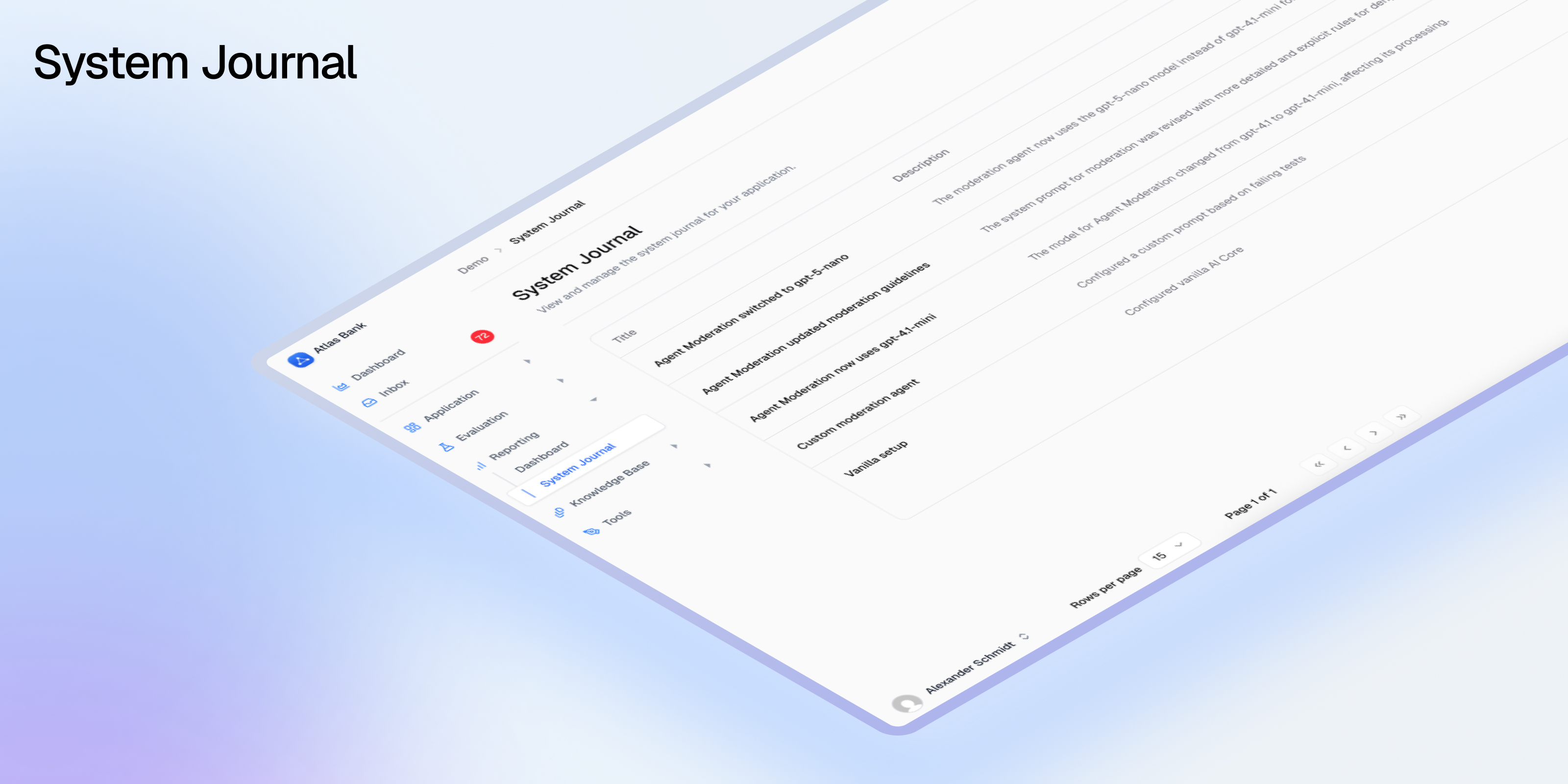Skip to main content
What is the System Journal?
The System Journal is an intelligent monitoring system that automatically tracks and documents all significant changes in your AI model deployments. It serves as your automated compliance officer and operational guardian, creating a comprehensive audit trail of configuration changes, parameter modifications, and data anomalies across all your AI traces.
Think of it as a “black box recorder” for your AI systems—capturing every meaningful change that could impact model behavior, compliance, or evaluation accuracy.
Key Capabilities
- Automatic Change Detection: Identifies when model parameters (temperature, max tokens, top-k, etc.) change between deployments
- Missing Parameter Alerts: Flags when critical parameters required for evaluation or compliance are absent
- Intelligent Journal Entries: Generates human-readable descriptions of what changed, when, and by how much
- Complete Audit Trail: Maintains a tamper-proof history of all configuration changes for regulatory compliance
- Zero Manual Overhead: Operates completely automatically in the background
Why Use the System Journal?
For Engineering Teams
Prevent Configuration Drift
You’ll immediately know when model parameters change unexpectedly. No more debugging mysterious behavior changes or performance degradations caused by unnoticed configuration updates.
Accelerate Incident Response
When something goes wrong, the System Journal provides instant visibility into what changed and when. Instead of digging through logs, you can see at a glance: “LLM Temperature Changed: 0.4 → 0.9” with timestamps and context.
Maintain Evaluation Integrity
Missing parameters can invalidate your evaluation results. The System Journal ensures you catch these gaps before they impact your metrics or decision-making.
For Compliance Teams
Regulatory Readiness
Financial institutions face strict requirements for AI transparency and explainability. The System Journal automatically maintains the comprehensive audit trails regulators expect, reducing preparation time from weeks to minutes.
Risk Management
Track when risk-relevant parameters change (like content filtering thresholds or decision boundaries) and ensure they stay within approved ranges.
Evidence Collection
Every journal entry includes timestamps, before/after values, and trace context—everything needed for compliance reporting or incident investigation.
Real-World Impact
Consider this scenario: A wealth management firm’s AI-powered client communication system suddenly starts generating longer, more creative responses. Without the System Journal, this could go unnoticed for weeks. With it, compliance immediately sees: “LLM Temperature Changed: 0.2 → 0.8” and “Max Tokens Changed: 150 → 500”—catching a potentially risky configuration change before it impacts clients.
How to Use the System Journal
Accessing the System Journal
- Navigate to the System Journal section in your Avido dashboard
- You’ll see a chronological list of all journal entries across your AI systems
Understanding Journal Entries
Each System Journal entry includes:
- Type Indicator: Visual icon showing the category (change, missing parameter, error)
- Clear Description: Plain-language explanation like “Model version changed from gpt-4-turbo to gpt-4o”
- Timestamp: Exact time the change was detected
- Trace Link: Direct connection to the affected trace for deeper investigation
- Change Details: Before and after values for parameter changes
Viewing Journal Entries in Context
On the Dashboard
System Journal entries appear as reference lines on your metric graphs, showing exactly when changes occurred relative to performance shifts.
In Trace Details
When viewing individual traces, associated journal entries are displayed inline, providing immediate context for that specific execution.
In the System Journal List
The dedicated System Journal page provides:
- Filtering by entry type, date range, or affected system
- Sorting by relevance, time, or severity
- Bulk actions for reviewing multiple entries
Common Workflows
- Notice a metric shift on your dashboard
- Check for System Journal markers at the same timestamp
- Click through to see what parameters changed
- Review the trace details to understand the impact
Compliance Review
- Access the System Journal for your reporting period
- Filter by the relevant AI system or model
- Export the journal entries for your compliance report
- Document any required explanations or approvals
Responding to Alerts
When the System Journal detects missing required parameters:
- The entry clearly identifies what’s missing (e.g., “Missing Parameter: topK”)
- Click through to the affected trace
- Update your configuration to include the missing parameter
- Verify the fix in subsequent traces
Best Practices
Regular Review Schedule
Set up a weekly review of System Journal entries to catch trends before they become issues.
Tag Critical Parameters
Work with your compliance team to identify which parameters are critical for your use case, ensuring the System Journal prioritizes these in its monitoring.
Integrate with Your Workflow
- Set up alerts for critical changes
- Include System Journal reviews in your deployment checklist
- Reference journal entries in incident post-mortems
Use Journal Entries for Documentation
The System Journal creates a natural documentation trail. Use it to:
- Track experiment results
- Document approved configuration changes
- Build a knowledge base of parameter impacts
Advanced Features
Entry Classification
Different System Journal entry types use distinct visual indicators:
- 🔄 Configuration Changes: Parameter modifications
- ⚠️ Missing Data: Required fields not present
- 🔍 Anomalies: Unusual patterns detected
- ✅ Resolutions: Issues that have been addressed
Intelligent Grouping
When multiple parameters change simultaneously, the System Journal groups related changes into a single entry for easier understanding.
Historical Analysis
Compare current configurations against any point in history to understand evolution and drift over time.
Getting Started
- No Setup Required: The System Journal begins working automatically as soon as you start sending traces to Avido
- First Journal Entries: You’ll see your first entries within minutes of trace ingestion
- Customization: Contact your Avido representative to configure specific parameters to monitor or adjust sensitivity thresholds
The System Journal transforms AI observability from reactive firefighting to proactive governance, ensuring your AI deployments remain compliant, performant, and predictable. 